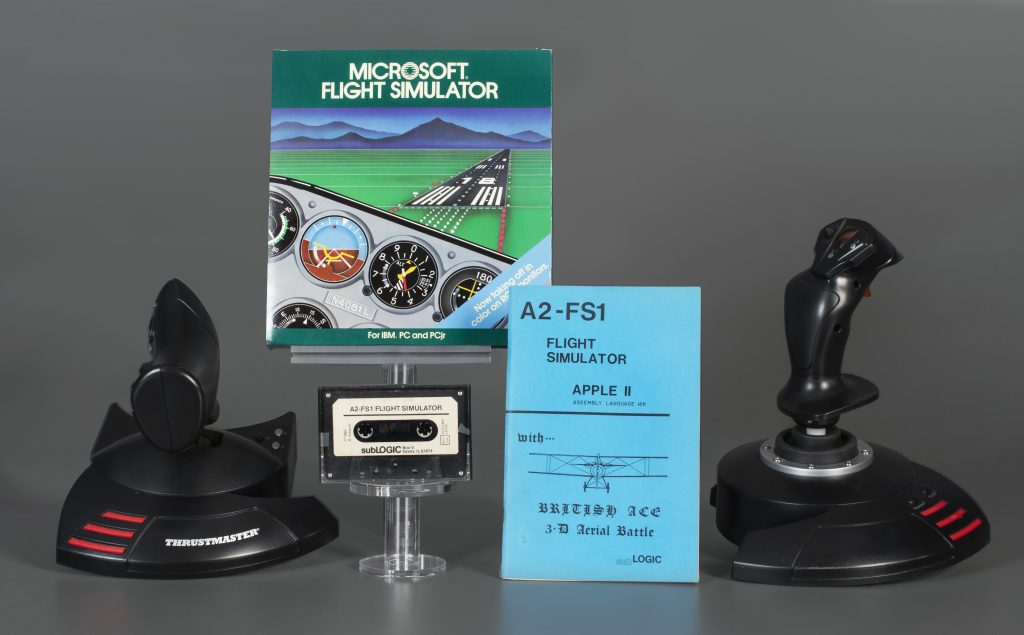Inducted Year: 2021
Flying has fascinated humanity since ancient times, but it was only in the twentieth century that heavier-than-air flight took off. Thousands of amateur and professional aviators pursued their dreams of navigating machines through the sky, but most people experienced flying as passengers, not pilots. Learning to fly was expensive, time-consuming, and (especially in the early years) dangerous. Microsoft Flight Simulator changed all that, by giving millions of people a highly realistic simulation of piloting a real plane, all without leaving the comfort and safety of their computers.

It is hard to overestimate what a groundbreaking program Microsoft Flight Simulator was when it debuted in 1983. Bruce Artwick, its creator, had studied at the University of Illinois, then a leader in computing with its PLATO network. For his master’s thesis, he developed a flight simulation program on the DEC PDP-11 minicomputer. After founding SubLogic Corporation with Stu Moment, he created A2-FS1 Flight Simulator for the Apple computer (and released a TRS-80 version called T80-FS1). That game became the best-selling flight simulator at the time, consistently ranking in Softalk magazine’s Top Thirty poll of computer sales during its first two years of release, from 1980–1982. It is thus not coincidental that Microsoft, on the cusp of its huge increase in scale through its partnership with IBM on the PC, decided to license a version of Artwick’s creation.
Microsoft Flight Simulator didn’t merely port the older programs to the new computer, but instead Artwick built in a wide variety of new features. The game retained the older version’s cockpit view, smooth simulation, and engaging play, but Artwick took advantage of the new computer’s 16-bit processing power to add many new features when it was released on November 11, 1982. The use of color made flying this simulated Cessna 182 single-engine plane highly realistic, enabling the player to make choices while flying that echoed the way a real-life pilot made judgments based on visual changes in the landscape. While complex—the game came with a massive manual that had rules and guides for both VFR (visual flight rules) and IFR (instrument flight rules)—it nonetheless was intuitive. Particularly important to the game’s success was its inclusion of an editor that allowed the player to vary the scenarios by adjusting the weather, shifting the season, and even changing the location of flight. Since it operated in real-time, a player who decided to fly from Chicago to Seattle needed to plan accordingly!
Microsoft knew it had a hit on its hands, and in collaboration with Artwick and others released a regular series of updates. The 1988 3.0 version let players view the plane from the outside for the first time, and Artwick continued to work on updates until the version for Windows 95 when he sold his company BAO (Bruce Artwick Organization) to Microsoft. The game’s success continued, especially as new versions added maps for flying all over the world. By 1997 the series had sold more than 10 million copies, and Microsoft Flight Simulator 98 was another best seller. The 2006 version FSX brought the game to new heights but also marked a significant pause in the game’s development as Microsoft shut down the game’s developer Aces Game Studio not long after. However, in 2020, Microsoft released a spectacular updated version of the game that used real images to give fliers the experience of soaring over their hometowns or visiting exotic locales. The latest version has sold millions of copies.
The joy of flight is universal, and perhaps that is why Microsoft Flight Simulator—the most popular, longest lasting, influential flying sim of all time—has continued to captivate gamers for decades.
Did You Know?
In the original Microsoft Flight Simulator, players could only explore virtual Los Angeles, New York City, Seattle, or Chicago. In the 2020 installment, the entire Earth is at a player’s fingertips.




